October 8 - 14, 2023: Issue 600
Dee Why Hotel Opens In 1930: Introduces 'Beer O'clock' For Thirsty Locals
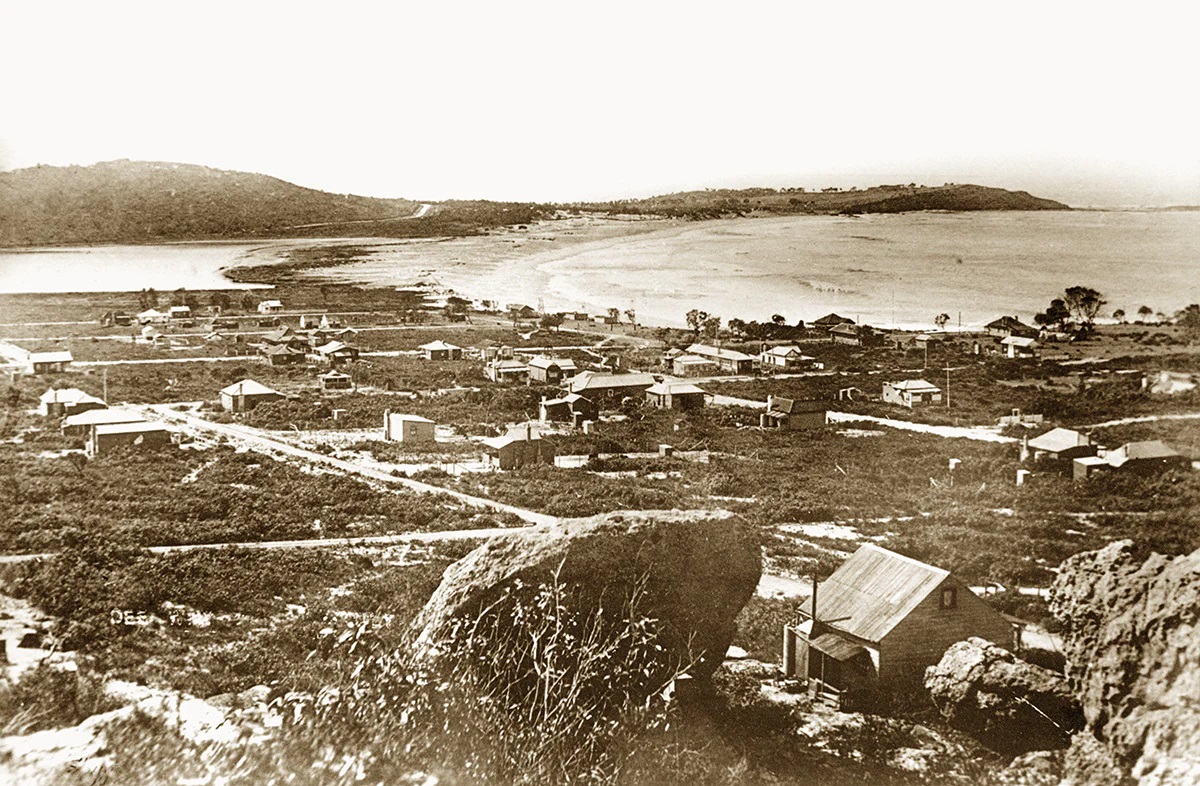
As the weather starts heating up locals start visiting their own 'local' a bit more often for a cooling glass of ale in what is known as 'beer o'clock'.
The practice of meeting up for a chat and a beer should not be taken for granted though. In George Repin's 2013 article 'Alcohol In Restaurants Before 1955' he explained:
People in restaurants and coffee lounges enjoying a glass of wine with their meal today probably have no idea of the limitations which applied, until the 1950’s, to the service of alcoholic beverages.
Restaurants with liquor permits were severely restricted. They could serve only “light wines” and “malted liquors” which could be “served only in a sealed bottle at the table at which the purchaser is seated and … opened in his presence”. The civilised practice, long established in Europe, of being able to have a single glass of wine with a meal was totally prohibited. No other alcoholic drinks, such as spirits, fortified wines or cocktails were permissible. Restrictions also applied to the design of restaurants with liquor permits. For example, they had to have at least 50 seats, which had to be individual chairs not loge or bench type seating – presumably for fear of what people might get up to if “inflamed” by alcohol.
A “meal” was strictly defined in the liquor laws as being “…of at least two courses at which the persons partaking thereof are seated at a table, and one course of such meal shall consist of fish or meats, other than in sandwich form, and cooked vegetables.” Salads did not comply and bad luck for the vegetarian.
In the evenings, unless it was convenient to eat between 6 pm and 9.30 pm service of a drink was unlawful.
Dee Why was among the last local suburbs to have somewhere for people to meet and enjoy a tipple, almost five decades after the Newport Hotel opened in the early 1880's.
Local residents petitioned for a hotel in Dee Why in 1929, although a covenant existed which stipulated that no liquor should be manufactured or sold on land which was previously owned by the Salvation Army.
There had been preceded by:
HOTEL COLLAROY ?
SHIRE PRESIDENT AGAINST IT
Councillor- Arthur George Parr, president of Warringah Shire,- an office which he has held continuously for seven years, except for a break of two months this year, gave evidence before the Licensing Court to-day against the petition for a hotel license for Collaroy.
The class of people who had made the district did not desire a hotel, he said, and in his opinion would get no advantage from it.
"If there is need of a hotel at Collaroy," said Mr. Parr, "there is similar need at Harbord, Dee Why, and every other beach where people gather at holiday seasons. The time has not yet come for more hotels in the district."
Mr. Parr said he never drank alcoholic liquor, but his opinion was based on a public and not a personal view. HOTEL COLLAROY ? (1926, July 6). The Sun (Sydney, NSW : 1910 - 1954), p. 13 (FINAL EXTRA). Retrieved from http://nla.gov.au/nla.news-article222721949
The residents were successful though and the Dee Why Hotel opened in 1930. A description from; Building : the magazine for the architect, builder, property owner and merchant., Vol. 47 No. 277 (12 September 1930) provides:
TWO VIEWS OF THE DEE WHY HOTEL, SYDNEY
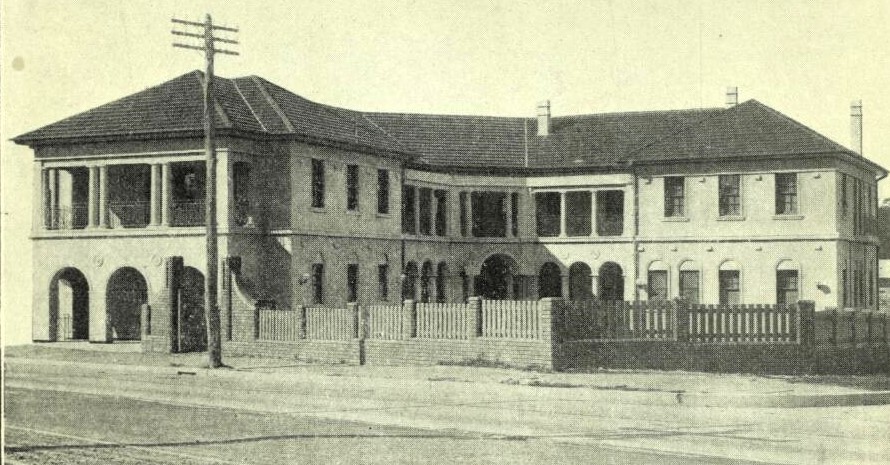
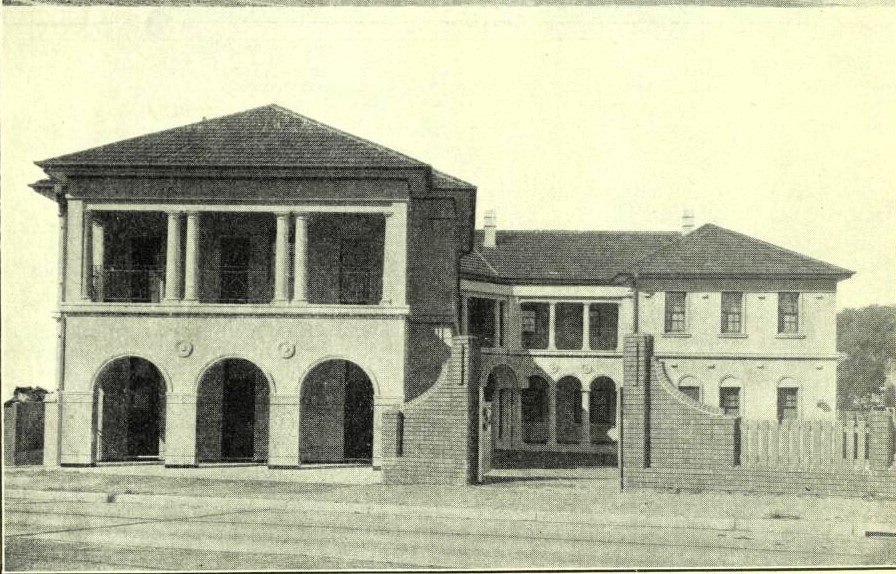
Messrs. Copeman and Lemont, Architects. Messrs, Mossop and Cooper, Master Builders
As will be realised, the planning of this building is on different lines from those generally adopted for this class of work; doubtless the result of favourable conditions as to site, aspect and originality on the part of the architects. Cars may be driven right up to the main entrance or they can be parked inside the grounds, which is often very convenient.
The upper illustration reveals the whole of the angle courtyard while the lower shows the attractive proportions of the street façade; the only criticism that can be levelled at this front is that the panels between the upper columns seem to be a little square, a fact which would have been greatly improved had more weight been given to the flanks —possibly another column as well as the engaged one present.
THE DEE WHY HOTEL
Something New in Hotel Layout.
A public house —a pub! What impression did that very oft heard remark usually cause to rise before one’s eyes?
A particularly uninteresting and uninspiring sight —to all except those to whom it was the store-house of the elixir of life: a two-storey edifice, with verandah posts at the kerb supporting a clumsy balcony overhead, adorned with a cast iron railing and a few neglected looking plants; below, a few dark doorways and a band of imitation painted marble, formed a background for the Iocal lads, who, draped about in various poses, complete the tableau.
To-day that is all gone—is prehistoric, in fact, and the modern hotel could never be called a “pub” for its mere architectural superiority vetoes the word on our lips.
The Planning—Something New
The new Dee Why Hotel is such a modern example. Fresh, colourful, cheerful. clean, and wholesome, it is a great asset to the locality. (The time was once that the hotel was certainly not an asset to a district).
The building is situated on a corner site, of which the greatest advantage has been made, the plan being disposed as two angular wings, allowing the interior of the so formed right-angle to provide the driveway for motor traffic. The main entrance is in the internal angle of these two wings. Passing through this portal, the large vestibule, which is in the shape of a rectangular chamber with two triangular ends, is entered; from this central area doors lead to the saloon
bar and the saloon parlour at one end and the office and dining room at the other, while opposite the front door are the stairs. This arrangement is obviously the essence of convenience, since, from this hub. as it were, access is obtained to every public section of the accommodation.
The planning of this building is particularly good, the bar section being effectively isolated from the residential portion with consequent privacy- and quietude, while at the same time it is right on the street in a convenient position to dispense “regailers.”
The Public Rooms
The public bar is tiled with putty coloured tiles, the counter and woodwork being all of maple. The saloon bar is treated with red tiles and similar maple woodwork, which in conjunction with the gleaming mirrors behind the various interesting-looking bottles, form a very satisfactory colour scheme; in fact it would be hard to find anything more comfortable than to put the foot on the brass foot-rail and “lower a flowing glass.” The parlour, where one may sit down to enjoy life, is adjacent.
The dining room is a fine, large room, opening on to a columned verandah that overlooks the angle court; the walls are strap-panelled with maple, in between which is a rich paper, promoting warmth and intimacy, and at the extreme end is a jolly looking fireplace of rich red briquettes. Upstairs, occupying a position immediately above the vestibule, is a lounge, opening out on to a spacious balcony, which is very centrally situated to all the bedrooms; it also has a fireplace (it is essential to take special notice of all fireplaces that are seen days, for they appear to be fast going out of fashion).
The accommodation consists of eight double bedrooms and ten single; all of these are splendid rooms —none of your cramped, dingy chambers —each being provided with a handbowl with hot and cold water, on a tiled panel above which is an inset mirror and a glass shelf for shaving utensils and sundry pill bottles. The provision of these conveniences is a splendid idea and eliminates all those harassing waits in bathroom queues that are so enraging (seeing a rival just pop in while you have fallen into a sleepy trance).
Every bedroom except two opens onto a balcony. Four bathrooms are provided with plunge baths and hot and cold shower-spaces, while ample and convenient linen and cupboard space assists the bedroom service.
The kitchen is conveniently placed in relation to the dining room, though care has been taken to provide against annoyance from noise and cooking vapours; special glass, silver and store rooms are also incorporated.
The Exterior
The exterior of the building is cement rendered (“Bondex,” G. E. Crane & Sons Ltd.) and finished to a yellowish tint, which is very pleasing when touched by sunlight, but a little crude in shadow; however, a little weathering will correct that. The wall is crowned by a frieze on which is worked a simple running ornament, and then terminated by boxed eaves, which are gaily treated with a jade green guttering and fascia and ruby-coloured gutter and bedmoulds; these fresh colours go well with the wall finish and merge into the mottled tiled roof in a satisfactory manner. The balcony and verandahs before mentioned, are contained in the internal angle of the building and are suitably treated with columns and green ironwork, though the circular hood-like awning over the main entrance appears heavy and clumsy and looks like a very unfortunate afterthought to give emphasis to the main portal. The entrance doorway is of maple and is set off by an elliptical fanlight and sidelights infilled with leadlights with broad cames run in simple patterns.
The street front of the bar has three large circular openings topped by coupled columns in the balcony; the design of this façade is excellent, the proportions being good, though the green mottled tiles round the lower part of the piers are to be regretted as being a little vivid.
General
The forecourt is to be adorned with a garden plot skirting the drive which enters and emerges out of two large double gates; these gates of green are of graceful design, while the gate and fence piers, of dignified outline and finished with a raked joint, impart a pleasing texture.
At the rear are four large garages, for the convenience of patrons, while a large drying ground is provided for laundry work.
Another feature of interest to architects, engineers and master builders is the septic tank installation. This takes the form of an ordinary septic tank, but has an effluent well automatically emptied by an electric centrifugal pump.
This well has a capacity of 1180 gallons, but the pump is so operated that as soon as 10 gallons has collected, it is automatically expelled, to be distributed by perforated pipes in rubble drains. The object of the large size of the well is so that if the pump should go out of order there is capacity for two days’ accumulation; a gauge is fitted to indicate the amount of effluent present.
This excellent installation was carried out by Home Sanitation Ltd., and is a noteworthy improvement on the old bailing and carting- away system.
It is very pleasing to see all these fine hotels being erected and especially at such recognised beauty spots as Dee Why. Here a very delightful, healthful and restful holiday could be spent, without the necessity of going too far afield.
Messrs. Copeman and Lemont, the architects, and Mossop and Cooper, the master builders, deserve hearty congratulation on the design and work.
DEE WHY HOTEL
The Entrance
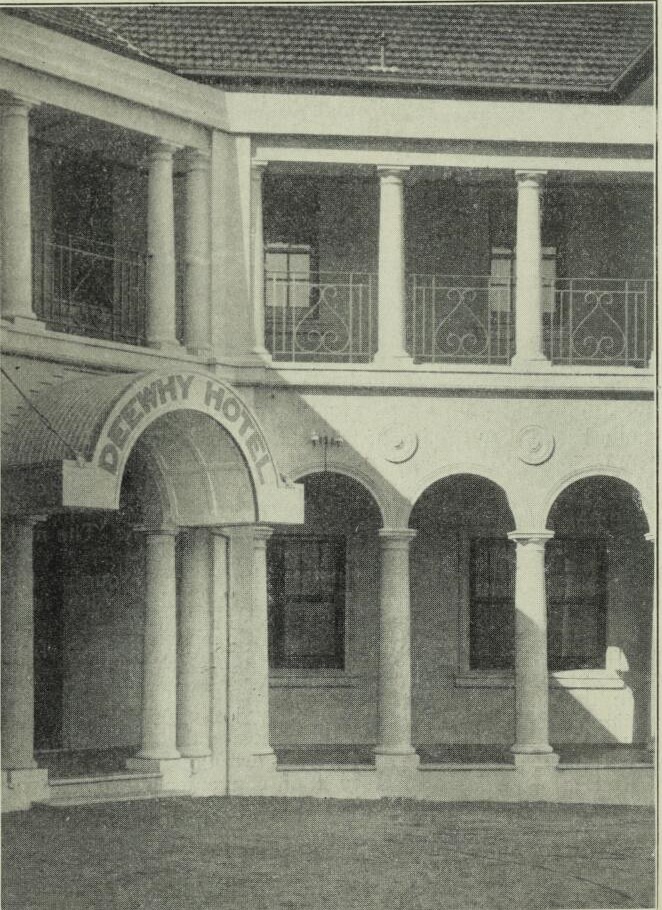
It seems very remarkable that in the midst of such a graceful architectural composition of columns, arches with moulded archivolts, paterae and wrought ironwork, an awning, lacking similar character should be intruded; we say intruded because we feel quite sure that the hand that designed the classic grace beforementioned could never spoil it in this way unless prevailed upon by an importuning influence. In fact, it is obviously an after-thought by the way it obtrudes its bulky presence onto the light abacus. The sight of the galvanised iron in such close juxtaposition to the wrought iron is to be deplored.
The architects were Messrs. Copeman and Lemont, the Master Builders Mossop and Cooper.
Federated Builders' Association of Australia & Master Builders' Federation of Australia. (1907/September 1930 edition). THE DEE WHY HOTEL Something New in Hotel Layout., Building : the magazine for the architect, builder, property owner and merchant Retrieved from http://nla.gov.au/nla.obj-348954238
The Tipping family – Neville Trevor (born 1912), son of Nigel and wife, Emily, were the licensees of the Dee Why Hotel from 1930 to 1954. Most of the family were involved in the hotel trade whether through working here or marrying someone, if daughters, who worked in the hotel industry.
Reading between the lines of what scant items could be found, the family was hard working, as all in the hotel industry have to be, and had an attitude of 'getting on with it', even when circumstances produced adversities:
WILL LOSE FOOT.
Trevor Tipping, 18, of Dee Why Hotel, Dee Why, was riding a motor cycle in Bridge Road, Drummoyne, when a lorry hit his machine. Tipping's left foot was crushed. He was taken to Sydney Hospital, where an amputation will be made. MOTOR TOLL. (1930, October 4). The Labor Daily (Sydney, NSW : 1924 - 1938), p. 7. Retrieved from http://nla.gov.au/nla.news-article236723454
The Big Leg Pull
Out of the past you get - the good stories. For instance, a novelty such as this one: "Mick" Tipping; son of the licensee of the Dee Why Hotel, Nigel Tipping, went along to the first. Jack Carrol-Ben van Klaveren fight at the Sports Ground. Remember, that was the night the rains came, '
"Mick" has an artificial left leg, having lost his own in a motor cycle smash.
He was clambering about to get a good seat at the Sports Ground, and the foot of the artificial leg snapped off with sock and shoe intact.
We were talking about It only the other day over a noggin at the Dee Why Hotel.
Nigel, the proprietor, chipped In: "And you should have seen the faces of some fellows when they saw a pal of "Mick" carrying the foot while we helped him hobbling over the ground.
"One of these fellows shouted, 'Hey! Strike me pink! Here's a bloke who's had his foot cut off!" Come Out Fighting with W. F. CORBETT (1945, June 20). The Sun (Sydney, NSW : 1910 - 1954), p. 12. Retrieved from http://nla.gov.au/nla.news-article230452229
£5 A DRINK AFTER HOURS AT DEE WHY
Three men, Dudley and James Fletcher and John Thomas Byers. were each fined £5, with 8/ costs, by Mr. MacDougal, S.M., at the Manly Court yesterday, for having obtained liquor by false pretences on April 11 at Dee Why Hotel. Each of them had signed the visitors' book as living at Penrith. They admitted, however, that they came from Drummoyne. £5 A DRINK AFTER HOURS AT DEE WHY (1931, May 1). The Daily Telegraph (Sydney, NSW : 1931 - 1954), p. 9. Retrieved from http://nla.gov.au/nla.news-article246254252
THIEF TRIED 20 ROOMS IN HOTEL
Daring Theft at Dee Why
A thief who, the detectives believe, is identical with the "cat" burglar, who visited six homes in the Mosman district on Friday night, demonstrated amazing daring when he broke into the Dee Why Hotel and a local cottage in the same district in the early hours of this morning. The thief entered 20 bedrooms at the hotel. They were all empty. Then he entered the room occupied by the licensee's daughter and stole a moneybox containing £2, a watch and some cash in a purse. In the kitchen of the hotel he forced open the money-box, and then ate some jelly from the ice-chest. Later he climbed into a girl's bedroom in a cottage not far from the hotel, and, when his flashing torch wakened the girl, the thief quietly walked out of the room. THIEF TRIED 20 ROOMS (1932, November 14). The Sun (Sydney, NSW : 1910 - 1954), p. 7 (CRICKET STUMPS). Retrieved from http://nla.gov.au/nla.news-article230572601
Unfortunately, the 'pub' was where one man lost his life:
MELEE AT DEE WHY
During a melee at the Dee Why Hotel yesterday, John Coates, 39, of Clarendon, near Richmond, fell with severe head injuries. Manly Ambulance took him to Manly Hospital, where he was admitted in a critical condition. Detective-Sergeant McNeall later arrested a man. MELEE AT DEE WHY (1940, January 21). The Sun (Sydney, NSW : 1910 - 1954), p. 3. Retrieved from http://nla.gov.au/nla.news-article231229963
FATAL BRAWL IN DEE WHY HOTEL
Coroner - Commits Man For Trial
Arthur Vivian Cochran, 28, grocer, was to-day committed for trial for manslaughter by the City Coroner (Mr. Oram), who inquired into the death on January 23, of John Thomas James Coates.
Coates was knocked down by Cochran in the bar of the Dee Why Hotel. Cochran, of Pacific-parade, Dee Why, to-day gave evidence that he hit Coates in self defence.
At the conclusion of evidence, the Coroner said; "The deceased died from a fractured skull, and there is no doubt in my mind that he received that in the bar of the Dee Why Hotel on January 20, and it was caused by the blow to the ' jaw by Cochran.
"Unfortunate Outcome"
"There is no doubt that this man had no intention of doing deceased any serious injury, it is just the unfortunate outcome. I must commit this man for trial. Whether the Attorney-General proceeds Is a different matter." Cochran was allowed bail of £50.
Sergeant O'Brien assisted the Coroner; Mr. J. H. Yeldham appealed on behalf of Cochran and Mr. Neil McTague (Penny and McTague) for the relatives of Coates. FATAL BRAWL IN DEE WHY HOTEL (1940, February 27). The Sun (Sydney, NSW : 1910 - 1954), p. 7 (LATE FINAL EXTRA). Retrieved from http://nla.gov.au/nla.news-article231231873
GROCER ACQUITTED OF MANSLAUGHTER
Arthur Vivian Cochran, 27, grocer, or Dee Why, was acquitted of a charge of manslaughter at the Central Criminal Court yesterday.. : The Crown alleged that John Thomas James Coates, 39, contractor, had died on January 23 with a fractured skull following a quarrel at Dee Why.
Cochran on oath said that all he had done was to act in self-defence. At the close of the case for the defence, the jury intimated that Cochran had acted in self-defence, and without hearing addresses he was found not guilty. GROCER ACQUITTED OF MANSLAUGHTER (1940, March 20). The Daily Telegraph (Sydney, NSW : 1931 - 1954), p. 6. Retrieved from http://nla.gov.au/nla.news-article247482556
By the outbreak of World War II in 1939, the schooner glass in NSW had shrunk to 16 Imperial fluid ounces.

Smaller beer glasses have been introduced in Sydney hotels, following an increase in the excise duty. The old and the new glasses are shown in this picture, taken to-day in a city hotel. – Sydney Sun September 19 1939.
Of course, that didn't stop too many for too long:
Calls Beer Drinkers Just Mugs
"Beer drinkers are a lot of mugs, said Mr. Jack Creagh. Archdeacon Hammond's Police Court Missioner for the Drunks, last night. He was commenting on the schooner-drinking competition, organised at Moree to find the local beer-drinking champion. The winner is to be matched against the Narrabri champion.
"In 27 years at the courts I have dealt with 2501)00 cases and I've been a drunkard myself— so I know what I'm talking about," said Mr. Creagh. "Any working man who thinks he can honestly afford 9d. for a pint of beer wants his head read.'' Calls Beer Drinkers Just Mugs (1940, February 26). Daily News (Sydney, NSW : 1938 - 1940), p. 1. Retrieved from http://nla.gov.au/nla.news-article236365225
The 10 ounce middy glass, priced at six pence, was introduced into NSW pubs in February 1941.The glass was introduced to appease disgruntled drinkers who were upset with the rise in beer prices. The middy glass was introduced to meet the demand for a six pence drink, and a 12 ounce “half schooner” was sold at seven pence.
Prior to 1941 the pot held 12 ounces of beer and was sold at sixpence. That same year, the Commonwealth Prices Commissioner sanctioned a new size beer glass. The new measure was to suit customers who would not mind having two ounces less in their glass after a beer price rise. In Sydney it’s known as the middy.
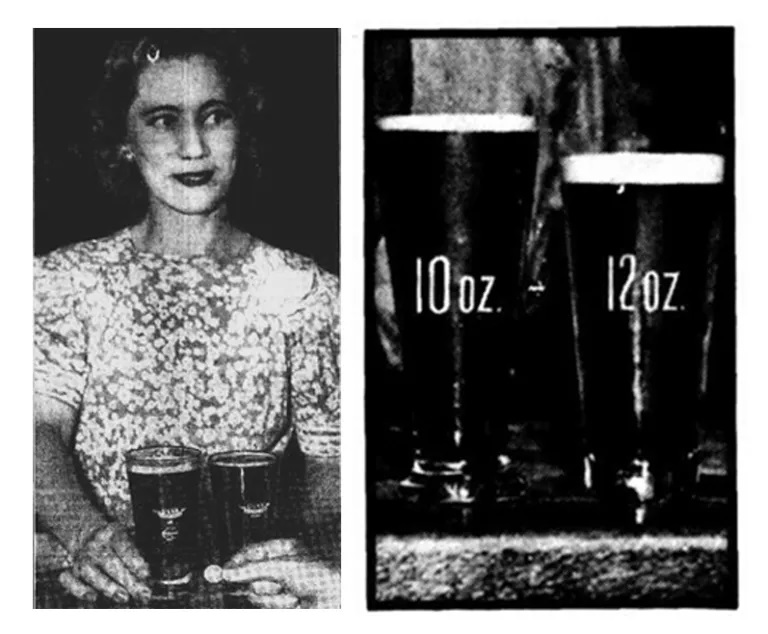
Left: Barmaid, Bonnie Reece in a Sydney hotel with the new “middy” February 1941. Picture: Daily Telegraph. Right: The new beer glass which will make its appearance in Queensland hotels to-day compared with the 12oz glass at present in use –The Brisbane Courier Mail Saturday 15 February 1941
There were some problems with 'half-full' glasses:
Warning On Short Beer
Mr. Oram, S.M., said yesterday that he would not deal lightly with hotel licencees who were selling short-measure beer. He refused a request at Manly Court that three licensees be let off under the First Offenders' Act, without penalty.
"While prices are rising a person expects to get the amount of beer he orders." Mr. Oram said. "I regard the matter very seriously."
Martin Joyce, weights and measures inspector, said that an Inspector who asked for a pint of beer in the Harbord Beach Hotel, Harbord, on December 13, was given 13 1/4 fluid ounces— 6 3/4oz. short. The inspector was charged 10d. The capacity of the glass was 15 fluid oz., 5oz. short of a pint.
"Tried To Snatch Glass"
"When the barman saw us start to measure the beer he tried to snatch it away," said Joyce. The licensee, Philip Dunphy, pleaded guilty and was fined £7 with 8/ costs.
Nigel Tipping, of the Dee Why Hotel, Dee Why, and Manly Hotels Ltd., of the Pacific Hotel, Manly, were fined a total of £10 for similar offences.
Joyce said Tipping sold a pint of beer 4oz. short on December 13. The Pacific Hotel sold a pint 3 1/2 oz. short, on December 30.
Raymond Raymond Leon List, of the Steyne Hotel, Manly, was fined £1 for having sold beer in an unstamped measure. Joyce said that an inspector who ordered a pint at the Hotel Steyne on December 13, was served in an unstamped measure, three-quarters of an ounce short. Warning On Short Beer (1941, January 24). The Daily Telegraph (Sydney, NSW : 1931 - 1954), p. 2. Retrieved from http://nla.gov.au/nla.news-article247515419
Last Boxing Day was not a happy one for mine host, Nev Tipping, of the Dee Why Hotel, Sydney. And yet it should have been. He had plenty of beer, a great number of customers, excellent drinking weather, and 2,000 brand-new schooner glasses. At closing time he only had 600 schooners left. Of the 2,000, over 1,000 were so damaged that they cannot be used again, and 400 were stolen. – Smith’s Weekly, January 9, 1943.
The discussion became an interstate affair, with this item from Victoria:
And of course, during World War II, with so many visiting service personnel, particularly Americans who, like Australians, are known to like a beer or two, making sure there was enough to go around meant introducing measures:
TOOTH'S BEER. Reduction of Supplies.
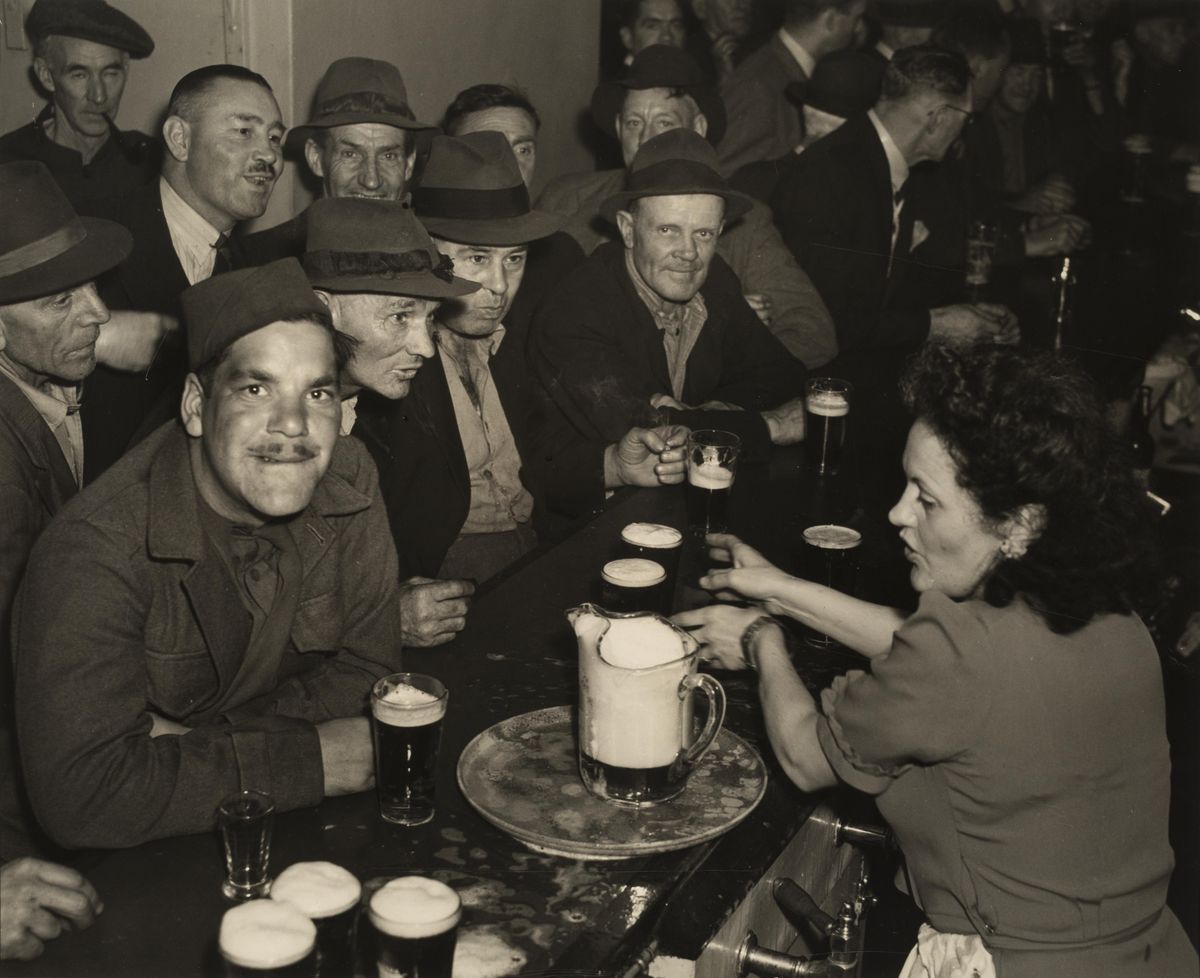
Max Dupain's photograph of A Barmaid at Work in Wartime Sydney. Petty's Hotel, Sydney, 6 pm, 1941. Gift of Shane Le Plastrier through the Art Gallery of South Australia Foundation 2016, courtesy and © 2023 Art Gallery of South Australia
Despite threatened boycotts and an outcry from NSW drinkers, the schooner glass was reduced from 16 fluid ounces (473.2ml) to 13 fluid ounces by the United Licensed Victuallers Association in 1945. The Sydney Daily Mirror reported on October 9 1945:
Question On Beer Glasses
As the terms "middy" and "schooner," by which some beer glasses were known, have no meaning under the Weights and Measures Act, the purchaser is not protected as to measure. 'THIS information was given by the Chief Secretary (Mr. Baddeley) in the Legislative Assembly today, replying to a question on notice by Mr. Arthur (Labor. Hamilton) regarding the size of beer glasses.
Mr. Baddeley said that it was assumed that when the National Security Act expired, the embargo on the sale of pints and half-pints would be removed. However, it must be pointed out there was no power in the Weights and Measures Act to force publicans to re-stock with pint and half-pint glasses and to serve such quantities on demand. He was of the opinion, however, that there was power to enforce this under the Liquor Act.
Members of all unions at Australian Glass Manufacturers have decided to support the Glassworkers' Union executive in its recommendation, that if the 'Federal and State Governments do not take action, members refuse to make the proposed 13oz, glass'. Question On Beer Glasses (1945, October 9). Daily Mirror (Sydney, NSW : 1941 - 1955), p. 3 (Late Final Extra 3). Retrieved from http://nla.gov.au/nla.news-article272485180
The Daily Telegraph the following day:
NO GOVT. CONTROL ON BEER GLASS SIZES
The State Government had no control over the size of glasses of beer sold in hotels, the Chief Secretary (Mr. Baddeley) said in the Legislative Assembly yesterday. He was replying to a question asked by Mr. Arthur (Lab., Hamilton) last week. Mr. Arthur asked if the Minister had noted a statement by U.L.V.A. officials that the size of the schooner was to be reduced from 16 ounces to 13 ounces. He asked if the Minister would approach the Federal Government for a return of powers to the State for re-introduction of the imperial pint and half-pint as just and equitable measures. Mr. Baddeley said control exercised before the war disappeared when National Security Regulations prohibited the sale of pints and half-pints and stipulated prices for different-sized glasses, such as middies and schooners.
Purchaser Not Protected
As these terms had no meaning under the Weights and Measures Act, the purchaser was not protected on the measure even in the hotels. Even before the war control had been limited, Mr. Baddeley said. If a customer asked specifically for a pint or half-pint, he was entitled to exact measure. But most hotels had used glasses of varying sizes. These were not required to be stamped or marked with any measure. If they were not filled, no charge could have been laid under the Weights and Measures Act. Mr. Baddeley said he assumed that when the National Security Regulations lapsed the embargo on the sale of pints and half-pints would be re-moved, but there was no power under the Weights and Measures Act to compel hotelkeepers to restock with pint and half-pint glasses. NO GOVT. CONTROL ON BEER GLASS SIZES (1945, October 10). The Daily Telegraph (Sydney, NSW : 1931 - 1954), p. 9. Retrieved from http://nla.gov.au/nla.news-article248024196
The following newspaper article published in the Daily Telegraph on April 13 1946 describes the shifts in Australian beer glass:
Beer drinkers are mugs
By VICTOR COLLINS
AUSTRALIAN beer drinkers are mugs. I ought to know. I’ve sold beer glasses and I know most of the tricks of the trade as they affect the ordinary drinker. If Sydney drinkers knew as much about deceptive beer glasses as I do, they mightn’t have been so anxious for B-Day to dawn last Wednesday after the brewery strike. The Australian drinker’s love of fancy names for the glasses he drinks beer out of — ‘mugs’, ‘pots’, ‘schooners’, ‘middies’, ‘lady’s waists’ — has enabled hotelkeepers to avoid serving standard measures, in all classes of hotels.
The only standard of measure that the law compels a hotelkeeper to have on his shelf and to supply on demand is the Imperial pint measure of 20 ounces. This container has two shapes — a handled mug and a conical tumbler, which are known colloquially as a ‘mug’ or ‘pot’ and a ‘schooner’.
When the public fell into the habit of calling for a ‘mug’ or a ‘schooner’ instead of for a pint, the way was opened for short measure. There is no law which defines the capacity of a ‘schooner’, ‘mug’, ‘glass’, or any other of the containers with fancy names.
The British scale of weights and measures knows no such containers. English and German glasses imported into this country were standard pint and half-pint sizes. With the arrival of the Japanese glass — cheap to import and, because of primitive methods of manufacture in Japan, unreliable in capacity — a new era opened for both the hotelkeeper and the glassware importer and distributor.
The drinker was accustomed to a glass that was tall and heavy. Would he notice if it were a little heavier in the base and the sides? Hotelkeepers thought he would not and a trial showed that they were right. There was nothing illegal in serving a glass containing less than 20 ounces of beer when the drinker called for a ‘schooner’ or a ‘mug’. Everything was right enough so long as the drinker did not notice the deficiency and raise objections.
A heavy “collar” he might object to, but he was unlikely to notice a heavy bottom. In the country, where freight charges on beer brought the price above city rates, many licensees found that, by using glasses of doubtful capacity, they could sell at a lower price than the man who sold pints and half -pints, and even sell at “city” prices,’ which was good for business. The chief selling points of the glassware distributors were that “deceptive” – glasses looked as large as glasses which contained two or three ounces more, and that by using deceptive glasses the publican could snake a greater profit from each keg of draught beer.
From my own experience as a glass salesman, I can state that many hotelkeepers readily paid three or four times more for “deceptive” glasses than for the true type. The U.L.V.A. put the stamp of its approval on this practice by having the Australian Glass Manufacturers turn out three styles of glasses in three sizes each, stamped with a scroll bearing the initials U.L.V.A. and a figure (since reduced) 9, 13, and 20 — implying that the contents were, respectively, 9 ounces, 13 ounces, and 20 ounces. None of these glasses was a certified measure.
If a glass actually contained as many ounces as was implied by the figure stamped on its side, it was purely coincidental.
With the outbreak of war in 1939, imports of Japanese glassware were cut off by the National Security Regulations governing non-essential imports. Production of deceptive tumblers was immediately taken up by local glassworks. Slightly different shapes were introduced, all of which successfully carried on the deceptive appearance now demanded by the Trade. Footed Ironglas tumblers, which held 9 ounces and were as large as the old 10 ounce glass, are now in regular use in milk bars.
The introduction of an Australian conical tumbler containing 9 ounces while maintaining the appearance of the 10 ounce glass resulted in Press protests, and a leading city distributor was criticised for retailing the glass. What escaped the notice of the general public was that the glass had been in use for some considerable time as one of the large number of “deceptive” sizes made in Japan to Australian indentors’ instructions. Nowhere was the drinking public imposed upon more than in booths at country race meetings and stock shows.
The standard glass used for the booth trade was a ‘lady’s waist’ tumbler as tall as the standard 7 ounce glass used in the saloon trade, yet so filled at the bottom and sides with glass as to contain only 3½ ounces. This glass was used for sixpenny drinks, and booth keepers paid 13 shillings and sixpence per dozen for it, against four shillings and threepence for the non-deceptive 7 ounce glass. In pre-war days, the 13 ounce glass was known as a “half -schooner,” and the name persisted even while the size was being whittled down by the Trade, which was not game to increase the price in cash because it knew the public would not stand for such a thing. Now the schooner is down to the 13 ounce size, which means that the drinker is paying nearly twice as much for his beer — and not all in taxes. In nearly every instance where beer Excise has been increased, the increase per glass has been so small as to be impossible to allocate on anything less than pint sizes. But in every instance the sizes of the glasses have been reduced to compensate.
Every time the Excise is increased, the publican— and the breweries — get a proportionate (or disproportionate) increase in their profit. The truth of this assertion is supported by a glance at the prices of brewery shares, the published figures of profits for the year to June, 1945, the amounts spent in repair and maintenance of hotel property. Since the Minister for Trade and Customs assures us that beer production was reduced by one -third during the war, it must be assumed that the wartime beer glasses have the property, not only of containing beer, but also of drawing an appreciable amount of the increased national income into the treasure chests of the Trade. Maybe the term ‘mug’, applied to a person easily imposed upon, was originated in a hotel bar. Beer drinkers are mugs (1946, April 13). The Daily Telegraph (Sydney, NSW : 1931 - 1954), p. 14. Retrieved from http://nla.gov.au/nla.news-article248497873
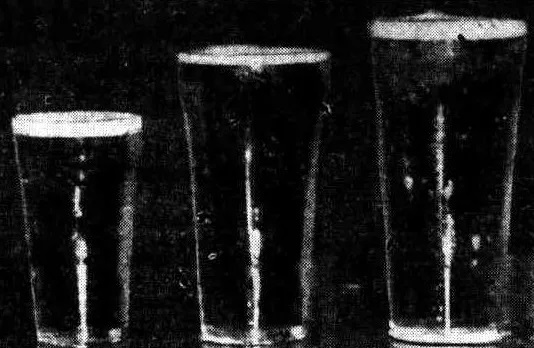
The 10 ounce middy glass, the 16 ounce schooner glass and the 20 ounce pint glass in 1941. – The Sydney Truth August 10 1947
The confusion was resolved in 1946 when new standard size glasses of 5, 10, 15, and 20 fluid ounces were gazetted by the NSW Government under the Liquor (Amendment) Act. Part 3 of the Act, which was gazetted in September 1946, and set down the beer glasses that are served today in most NSW pubs – the 140 ml (5 fl oz) ‘pony’, the 285 ml (10 fl oz) 'middy', 425 ml (15 fl oz) 'schooner' and 570 ml (20 fl oz) 'pint' glasses.
That didn't stop the beer from running dry though:
And there was still a requirement, then as it is today in restaurants, to offer the famous counter lunch or some other form of food so the beer didn't fall into an empty belly:
Licensees Fined; No Meals
SYDNEY, Monday.-Two Sydney hotelkeepers were fined a total of £40 in the Licensing Court today for having refused to serve meals. Geoffrey Verdun Scott, licensee of the Continental Hotel, North Sydney, was fined £30, and Nigel Tipping, licensee of the Dee Why Hotel Dee Why, was fined £10. Both pleaded "Guilty."
Mr. Wells, S.M., refused their requests that the convictions not be recorded. Mr. Wells said he regarded the offence as serious. He instructed the Metropolitan Licensing Inspector (Mr. Nunan) to inform the Court of Scott's conviction when the licence came up for renewal. Licensees Fined; No Meals (1949, March 8). Newcastle Morning Herald and Miners' Advocate (NSW : 1876 - 1954), p. 3. Retrieved from http://nla.gov.au/nla.news-article134344787
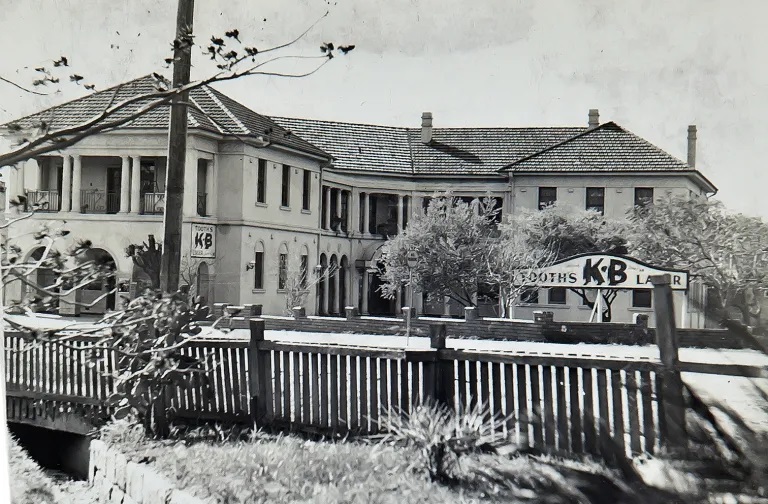
Dee Why Hotel, Dee Why NSW, 1949. Picture: Noel Butlin Archives, Australian National University.
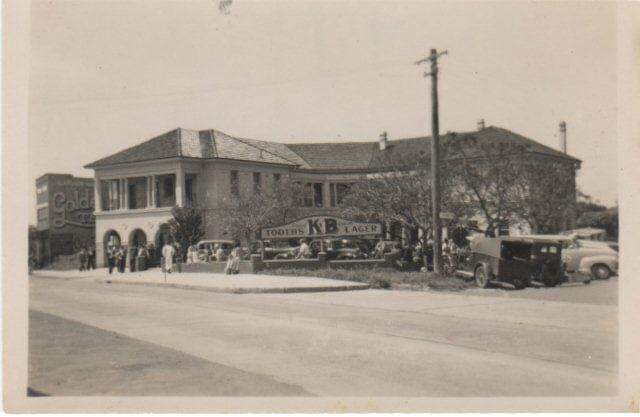
Neville Trevor Tipping, licensee of the Dee Why Hotel, Dee Why, told Mr. Dovey he charged 1/- deposit on beer glasses.
"Drinkers were taking the glasses outside and we were losing a lot," he said.
He denied he made any profit out of the system.
Tipping said he had never bought "deceptives" — glasses holding less than they appeared to hold. JUDGE CAUSTIC ON HOTEL CONDITIONS (1951, October 22). The Sun (Sydney, NSW : 1910 - 1954), p. 2 (LAST FINAL EXTRA). Retrieved from http://nla.gov.au/nla.news-article229727907
The patriarch of the family, Nigel (son of William and Maude), died in 1951.
TIPPING - The Relatives and Friends of the late NIGEL TIPPING, late of Deewhy Hotel, Deewhy, are kindly invited to attend his Funeral to leave our Private Chapel, 92 The Corso, Manly, This (Monday) Morning at 10.15 o'clock for the Northern Suburbs Crematorium. T WAUGH and CO. Manly Telephone XU1118
TIPPING - The Relatives and Friends of Mrs Emily Tipping, Mrs Cloris McLaughlan, and Mr Mick Tipping of Deewhy Hotel, Deewhy are kindly invited to attend the Funeral of her beloved Husband and their loving Father, NIGEL
TIPPING ; to leave our Private Chapel, 92 The Corso, Manly, This (Monday) Morning at 10.15 o'clock for the Northern Suburbs Crematorium. T WAUGH and CO Manly Telephone XU1118
TIPPING.—The Officers and Members of Lodge Narrabeen, No 427 U.G.L. of N.S.W., and Sister Lodges are kindly invited to attend the Funeral of their late Brother NIGEL TIPPING. Regalia at Crematorium. For further particulars see family notice.
F. D. Wildman, W.M.;
J. Sheppard, P.M., Secretary. Family Notices (1951, May 28). The Sydney Morning Herald (NSW : 1842 - 1954), p. 12. Retrieved from http://nla.gov.au/nla.news-article18228164
The United Grand Lodge of New South Wales and the Australian Capital Territory is the main governing body of Freemasonry within the Australian state of New South Wales that also wholly encloses the Australian Capital Territory containing the national capital city, Canberra. It originated from the union in 1888 of the earlier 1849 provincial Grand Lodge under the United Grand Lodge of England and other district and provincial Grand Lodges of the Grand Lodge of Ireland and the Grand Lodge of Scotland.
Freemasonry came to New South Wales with the regiments of the British Army soon after the First Fleet in 1788. It was banned by Governor King because of suspicions of republicanism.
The first stationary lodge, The Australian Social Lodge No.260 (Irish Constitution), was established by lodges working under Irish travelling warrants that were attached British regiments garrisoning the settlement in New South Wales. Lodge No.227 (attached to the 46th Regiment) and Lodge No.218 (attached to the 48th Regiment) admitted a number of civilians to membership and assisted in the dedication of The Australian Social Lodge in August 1820. In 1824, Lodge Leinster Marine of Australia, No.266 (Irish Constitution) was formed.
Freemasonry or Masonry refers to fraternal organisations that trace their origins to the local guilds of stonemasons that, from the end of the 14th century, regulated the qualifications of stonemasons and their interaction with authorities and clients. Modern Freemasonry broadly consists of two main recognition groups: Regular Freemasonry, which insists that a volume of scripture be open in a working lodge, that every member professes belief in a Supreme Being, that no women be admitted, and that the discussion of religion and politics do not take place within the lodge; and Continental Freemasonry, which consists of the jurisdictions that have removed some, or all, of these restrictions.
The degrees of Freemasonry retain the three grades of medieval craft guilds, those of Entered Apprentice, Journeyman or fellow (now called Fellowcraft), and Master Mason.
Freemasonry describes itself as a "beautiful system of morality, veiled in allegory and illustrated by symbols".[38] The symbolism is mainly, but not exclusively, drawn from the tools of stonemasons – the square and compasses, the level and plumb rule, the trowel, the rough and smooth ashlars, among others. Moral lessons are attributed to each of these tools.
Changes were made soon after the family left:
BEER GARDENS AT AUBURN, DEE WHY
£190,000 on hotels
Improvements to two suburban hotels costing £190,000 were approved by the Licensing Court today.
They are Auburn Hotel, at Auburn Rd., and Queen St., Auburn and Dee Why Hotel, Pittwater Rd., Dee Why. The Court was told the present Auburn Hotel building would be demolished and a new building with large, bars and a beer garden erected at a cost of £93,000.
Improvements costing £97,000 to the Dee Why Hotel would include large new bars, a beer garden and a lounge with snack bar. Metropolitan licensing inspector McLelland reported that the hotels would provide satisfactory drinking facilities. Applications for the improvements were made by Tooth and Co., Ltd. BEER GARDENS AT AUBURN, DEE WHY (1954, September 15). The Sun (Sydney, NSW : 1910 - 1954), p. 22 (LATE FINAL EXTRA). Retrieved from http://nla.gov.au/nla.news-article229895454
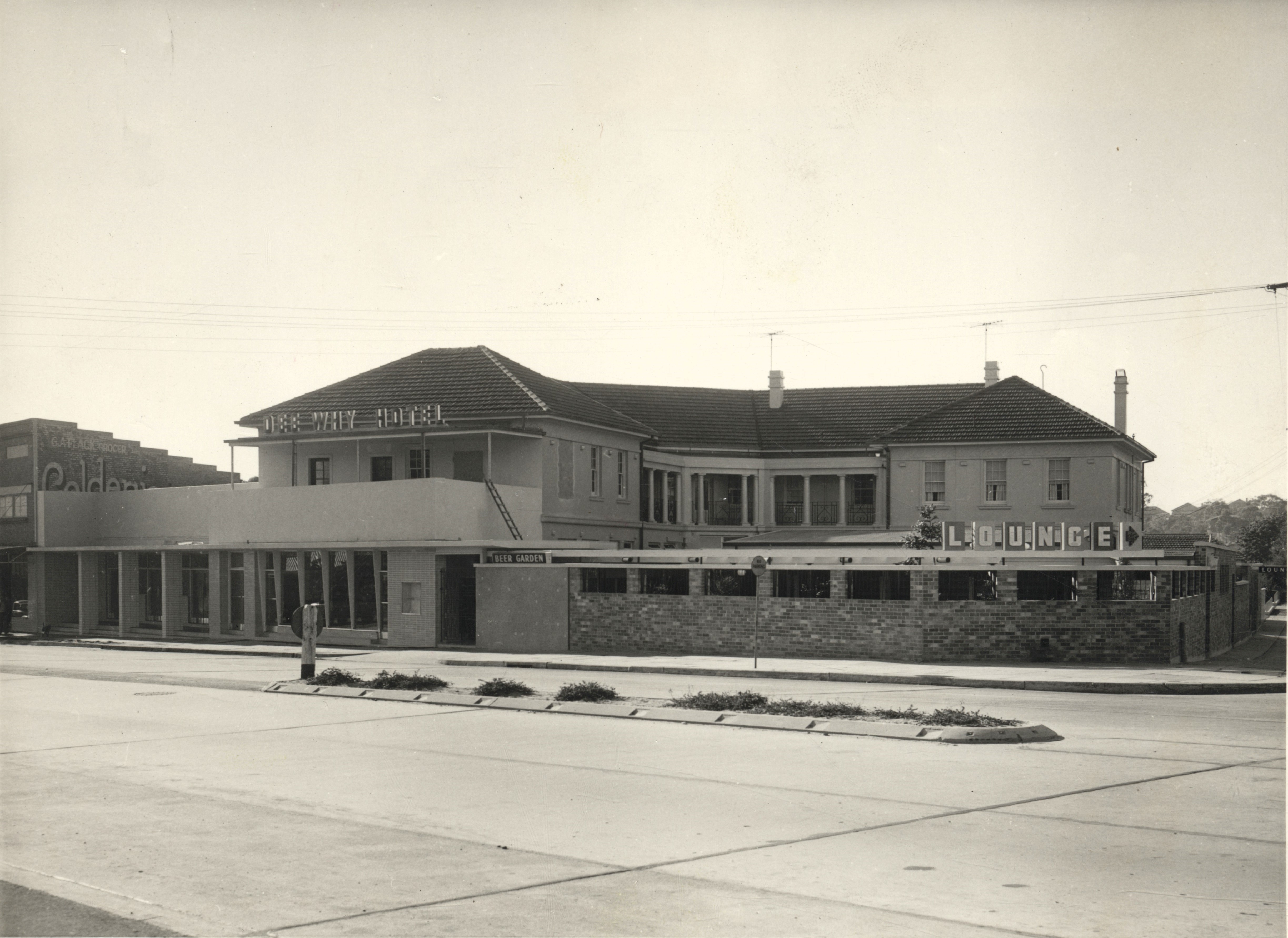
Dee Why Hotel, Dee Why NSW, no date, circa 1955/60. Picture: Noel Butlin Archives, Australian National University. Taken for Tooth and Co. Ltd. Photographer: John Fullerton
There were also other changes introduced in 1954. George Repin explained in his article:
Conditions for drinking in hotel bars were characterised by the expression “the 6 o’clock swill”. Even in up market hotels such as Ushers and The Carlton in Castlereagh Street the bars were packed before 6 pm when the hotel doors were closed in accordance with the law and service stopped. Men jostled to buy and line up on the bar glasses of beer before 6 o’clock to drink in the twenty minutes before the call “Time gents please” emptied the bars at 6.20pm – again according to the law.
Major changes flowed from the Royal Commission into the Liquor Industry.
In 1951, because of great abuses in the liquor trade and extensive corruption in the policing of the liquor laws, a Royal Commission was established by the N.S.W State Government. It was conducted by Mr Justice Allan Victor Maxwell. After 140 days of public hearings, the examination of 411 witnesses and the receipt of 109 pieces of written evidence the Commissioner’s report was released in February, 1954, with significant findings and recommendations.
Inter alia, the Commission concluded that “there can be no doubt upon the evidence that in the metropolitan area conditions associated with six o’clock closing are deplorable; apart from any other consideration, a refusal to attempt some reform involved in my opinion, the conscious perpetuation of a clearly established evil; in addition the present closing hour encourages sly grog and after-hour trading at ‘Black Market’ rates.”
While the Report mainly addressed issues not related to restaurants, subsequent action to amend the Liquor Act gave the Caterers’ and Restaurant Keepers’ Association the opportunity to press for the changes it had long been advocating. Amendments drafted by the Association, dealing with the service of alcohol in restaurants, night clubs and catering establishments, were submitted to the Minister of Justice by a delegation in June, 1954. They covered matters such as trading hours, type of food served, service of aperitifs, spirits and wines by the glass, and the provision of bars in restaurants where customers could have a drink before sitting down for their meal.
The Liquor (Amendment) Bill introduced in the Legislative Assembly on 1 December, 1954 was a historic sensible step towards allowing the people of N.S.W to enjoy drinks, served in a civilised way, with meals in restaurants.
Further changes were to come in later years but the first big move away from the bad old days had begun.
Now, as then, this large comfortable hotel has drawn locals and visitors, especially during hot weather, to its cooling interiors, so much so that sales of drinks placed the pub in the records:
Dee Why drinkers 'thirstiest'
SYDNEY: The Dee Why Hotel in Sydney's north had the thirstiest drinkers in NSW, the Chief Secretary, Garry West, said yesterday. Mr West said the hotel had retained its record for selling more alcohol than any other licensed premises in the state.
The Penrith Rugby League Club was the top-selling club in NSW, edging out last year's leader, Twin Towns Services Club at Tweed Heads on the state's North Coast.
According to Mr West, the patrons at the Colyton Hotel, near Mount Druitt on Sydney's western outskirts, were the biggest country drinkers in the state.
Mr West said the rankings were based on the level of alcohol sales on the premises over the last year, which is calculated to assess liquor-licence fees.
Total fees rose 12.9 per cent to $186.85 mil-lion for 1988-89, from $165.5 million the previous year. Mr West said this was more a function of higher excise taxes on alcohol sales rather than evidence that people in the state were drinking more. - Canberra Times (ACT : 1926 - 1995), Friday 6 January 1989
In 2007, the original Dee Why Hotel building was demolished and a new hotel was developed on the site.
The Dee Why Hotel's website provides the following on another much-loved local family and their investment in comunity:
40 Years: A Brief History
Dated: April 11, 2017
When digging into the Bayfield family history, there’s a reoccurring theme that runs deep through the family: Dee Why Hotel (affectionately referred to as ‘the pub’). There’s really no doubt about it, hospitality is in their blood. While this year marks the Bayfield Hotel Group’s 40th anniversary, we need to go back a little further to where it all began with Mark & Wayne’s late maternal Grandfather, Bill Wright, who spent his life working and managing pubs for over 50 years.
When Wayne finished school, his Grandfather Bill arranged a casual job for him in a pub, and Wayne was instantly hooked. Around the same time, Neville’s professional life changed and he decided to invest in a hotel with Bill. Not long after, an opportunity came up to take on Dee Why Hotel. So on Wayne’s 19th birthday they took over the hotel and a short time later, Mark joined them in the business.
Despite the success and growth of the business, Neville always put his family first. “Our dad lived his life for his family, and being publicans, having family work in the business was very important,” said Wayne. “We have been very fortunate that mum, dad, Mark, Yvonne, Sharon (Mark & Wayne’s wives) and myself have had a great relationship and can work together.” To this day, The Bayfield Hotel Group remains a tight-knit family, with many members currently working in the business.
The Bayfield Family
2017 marks the 40th anniversary of when the Bayfield Hotel Group was launched, with the Bayfield family taking over Dee Why Hotel on the 27th March 1977. Over the past 40 years, brothers Mark and Wayne Bayfield, along with their late father, Neville, expanded their pub portfolio, all while maintaining their family-run authenticity. In the true meaning of family business, Neville’s only grandson Kaine has recently been named as Chief Operating Officer for the business.
Presently, the group boasts an impressive portfolio that includes Dee Why Hotel, Bayfield’s Liquor Superstore at Dee Why, Bayfield’s online, The Light Brigade in Sydney’s eastern suburbs, and most recently the repurchase of Belrose Hotel. They previously owned The Caringbah Hotel, The Sands, Newport Mirage and are known most famously for The Newport Arms, which they owned for a remarkable 24 years!
As the years ticked by and the live music landscape changed, it was time for Dee Why Hotel to adapt. In 2007, they closed their doors and underwent a three year multi-million-dollar development that included a new hotel and bottle shop, shopping centre, commercial offices and residential apartments.
In August, 2010, it was reborn into a vibrant, eclectic bar that focused on intimate live soloist performances, a stand-out brasserie menu and a buzzy bar experience. It was important that the new Dee Why Hotel maintained its heritage and authenticity. from: http://deewhyhotel.com.au/blog/a-brief-history/
Redesign 2007 to 2010: Design practice; SJB Sydney, Surry Hills, Sydney, NSW, Australia - Project Team: Jonathan Richards, Nikki Johns. Details in: architectureau.com/articles/dee-why-hotel
The Dee Why Hotel no longer resembles its former self and is yet another tower added to the suburb that has rapidly transformed Dee Why from a place with views and green spaces into a wind tunnel, floodwater channelling place of concrete canyons along its Pittwater road sections. Older locals lament the passing of a building that had some character while younger members of the community appreciate its modern design.
Luckily the sun still shines on this all regardless of personal preferences in architecture and residents can run to the nearby beach or Stony Range Garden for respite before seeking out the shadowed interiors when it's beer o'clock in 2023.
Googles 2021 streetscape provides:
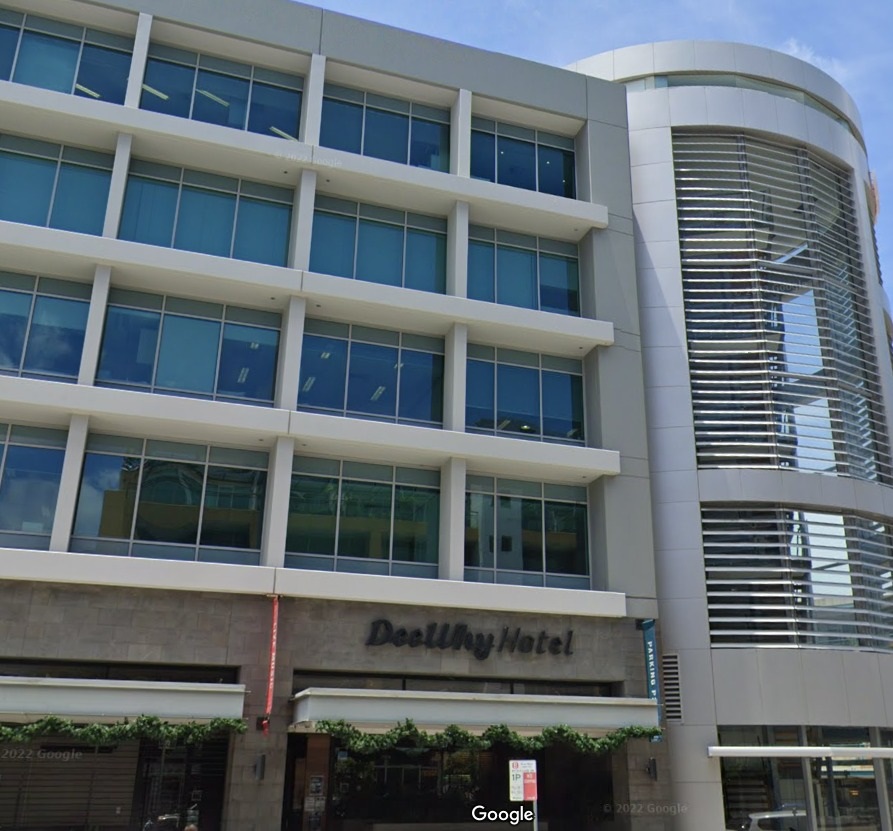
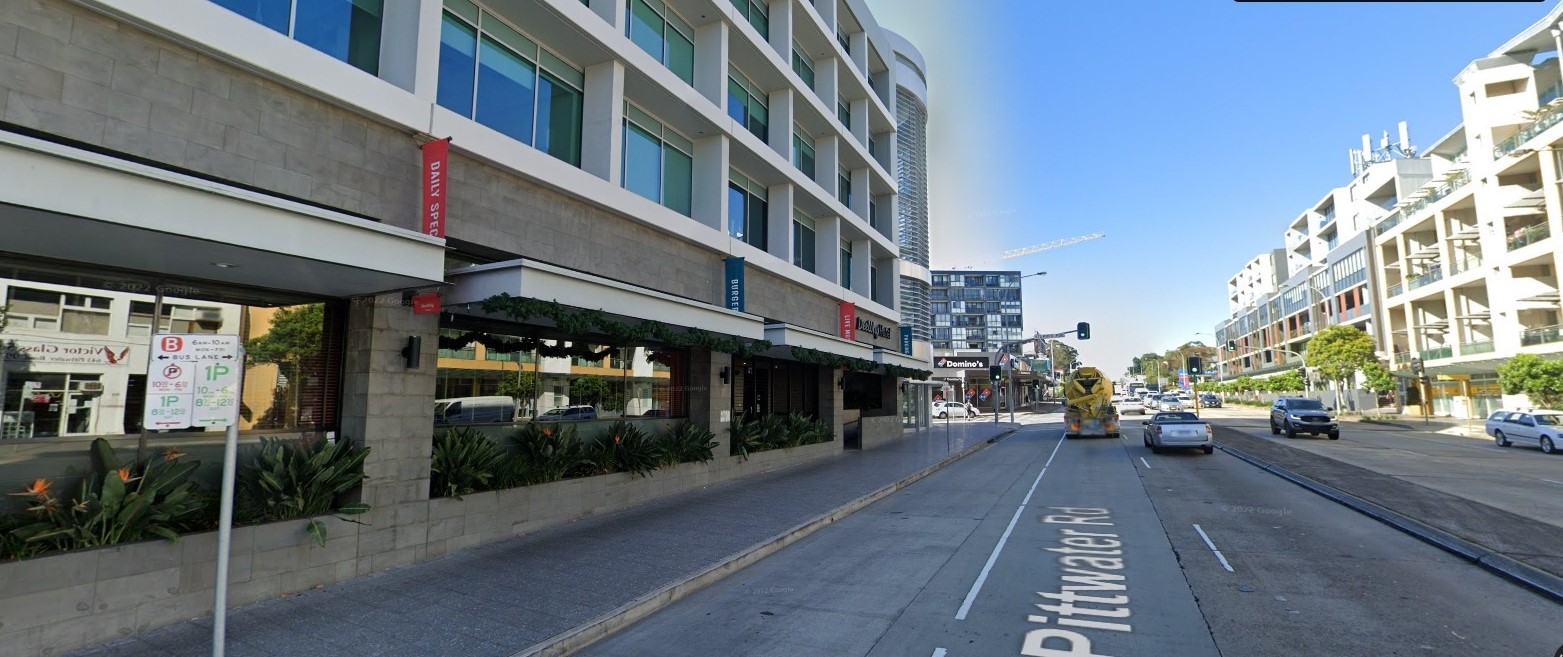
- Graham, Tina, Dee Why, Dictionary of Sydney, 2008, http://dictionaryofsydney.org/entry/dee_why
- TROVE - National Library of Australia
- Wikipedia contributors. (2023, September 27). United Grand Lodge of New South Wales and the Australian Capital Territory. In Wikipedia, The Free Encyclopedia. Retrieved 01:17, October 7, 2023, from https://en.wikipedia.org/w/index.php?title=United_Grand_Lodge_of_New_South_Wales_and_the_Australian_Capital_Territory&oldid=1177393553
- Repin, George. Alcohol In Restaurants Before 1955. Pittwater Online News. June 2013, Issue 116
- Guesdon, A. J. Year Dated Beer Bottles Found In The Estuary Adjacent To Taylors Point. Pittwater Online News. September 2017, Issue 329.
- Guesdon, A. J. Roads To Pittwater: The Pittwater Road. Pittwater Online News. July 2018, Issue 368.
- Lloyd, Ken. Dad's Fishing Shack At Long Reef - supporting research. Pittwater Online News. August 2018, Issue 373
- Bayfield family at Dee Why Hotel insights - courtesy Dee Why Hotel website.
MIGHT HAVE HAD £250,000, BUT GETS £2/10/- A WEEK
Sydney- Man Who Fought Salvation Army for Ancestral Estate
THE ARMY'S "NO BEER" COVENANT.
SO passes the glory of the world — in a mist of Blood and Fire. It is as well for Phillip Jenkins that he is a philosopher. The Jenkinses are gone — save for him, and he is 72, and childless. The homestead, built a century ago to nurse a proud line of colonial barons, has crumbled under the hands of the demolisher. The erstwhile forest lands are bare grassy hills scarred with new roads, and the old farm fields sprout a harvest of houses. Flivvers buzz over the landscape, trippers, weekenders, outer-suburbanites and market-gardeners throng the fertile valleys, and the estate agent is everywhere. And only yesterday all was silence, all was solitude.
The Jenkins held sway over a thousand acres, another settler ran cows back in the hills, a former assigned servant of James Jenkins tilled his land a little way up the coast, and between there and Brook-vale there was no one else to trouble the sea, and the sky, and the sand, and the scrub. As Phillip Jenkins grew up, fishing off Long Reef, hunting in the hills, riding over the estate that passed to his aunt Elizabeth, who had adopted him when his father died, others came to the district. It was still a wild region, the newcomers were wild folk, and wild deeds followed. They will still show you the place in the bush behind Narrabeen where murder stalked one night, and tell you that a convict came there to find a brutal master of earlier times, and strike him down. They will tell you how many a man was "put away" in those dark times by neighbors ill-disposed, and hint at wild orgies in the "Narrer Bean Camp" of the blacks — so called from the long slender native beans that grew beside the lake there. This was Phil. Jenkins' environment, but he was not of it. Up in the old homestead he lived under the care of an eccentric maiden lady who saw sin in almost all things, but who husbanded carefully the estate her father had left to her care. Phillip never thought hut that he would be heir to the lands his grandfather had pioneered. It was early in last century when James Jenkins came from England and started a shop in Sydney. Later a land grant of 200 acres at Deewhy was made to him and to one, William Cossar, a grant was made of 600 acres situated to the north of Jenkins' land. Jenkins later bought Cossar's land as well as 188 acres known as Sheep Station Hill on the northern side of Narrabeen lagoon. On re-measurement in after years this land is shown to be 259 acres. When Jenkins died, over 900 acres passed to his three surviving children— Elizabeth, Martha, and John. The other son, James, had died, leaving his son, Phillip, another part of the original holding-, which he later lost.
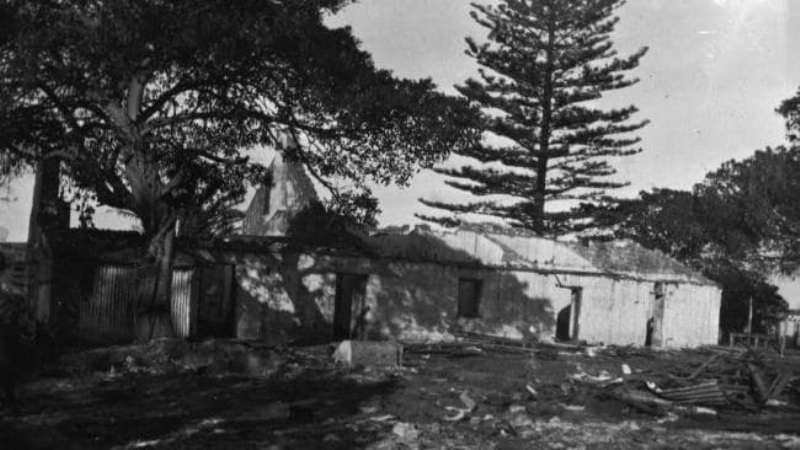
No 24. 'Ruins of Jenkin's home, Collaroy'. From album Historic pictures of Manly and Pittwater, 1856-1937 / compiled by Percy W. Gledhill, courtesy State Library of NSW
In 1885 Elizabeth, the leading spirit of the three, became interested in the work of the Salvation Army and from time to time she made gifts of money and land to the institution. Finally, in 1894 she was instrumental in having the whole of the land transferred to the Army in return for an annuity of £175, and an undertaking to take over her liability in connection with certain bank shares which she held. Miss Elizabeth Jenkins died in 1900 and her will under which she left all her remaining estate, amounting to £120, to the Army also, was attacked by Phillip Jenkins on the ground of incapacity and undue Influence.
Evidence in the Equity Court showed that she was an eccentric woman. The Judge refused probate, which had been asked for by Brigadier John Hendy of the Army, who, with Thomas Coombs, had been appointed executors. On appeal to the Full Court in 1901 this decision was reversed, Hendy and Coombs being granted probate. If the will could have been proved invalid, an attack would have been made on the deeds of settlement. At the time the deeds were executed an understanding was reached between members of the Jenkins family and the Army that although the latter was legally entitled to assume possession of the property, nothing would be done to disturb Its condition during the lifetime of any member or the family. This agreement was observed by the Army. Nothing was done until John's death about 1911 — Martha had died many years before. The tramway to Narrabeen was built in 1911-12 and opened for traffic on Eight Hours' Day, 1912. On that day the Salvation Army held its first sub-divisional sale, when land adjoining Collaroy Beach averaged over £5 a foot.
Conditions of that sale — and of all subsequent subdivisional sales— were that all fences erected must be approved by General William Bramwell Booth, and that the purchasers and the registered proprietors for the time being must not sell, permit to be sold, or connive at or be parties to the sale of any intoxicating liquors on the land. In addition, there was a condition in respect of the first sale prohibiting the carrying of liquor In the land.
Subsequently the Army applied to bring one part of the land, the area of which was 824 acres, under the Real Property Act, but the Crown claimed that Deewhy Lagoon of 62 acres, which was included in the application, was not a part either of the Jenkins or the Cossar grant. The present Chief Justice, sir Philip Street, sitting in Equity, held that the lagoon waters were not tidal, waters, and that they, were included in one or other or both grants, Followed an appeal, about 1910, to the High Court, which decided that the Crown was entitled to all the area from time to time covered by water. As Deewhy lagoon was continually being drained, the judgement that the ownership of the land would shift from the Crown to the Army, and vice versa, with the covering and uncovering of the land by water. The obvious difficulty of interpreting the ownership based on this unusual judgement resulted in a compromise being reached.
The estate, for the most part a narrow strip skirting the coast from Deewhy to Mona Vale, comprised originally about a thousand acres. The Salvation Army authorities have shown careful discrimination in in the manner of their throwing the estate open for sale, having regard to its value in the coming years as an aid to the Army's work. Large sums of money have been laid out in the developmental work— — in the construction of roads, bridges, etc. To date about two-thirds of the total area has been disposed of, and further sales are planned for the early future. On the estate the Salvation Army has established a colony for aged men, about 85 being in residence there: also a large Home for Boys. A section, at Collaroy, is set apart for the purposes of a seaside holiday ground — used, among, other things, as a fresh-air camp for poor mothers and children from the city and suburbs, also for children from various metropolitan Institutions. In addition It provides a summer camping ground for the Army's Life Saving Scouts and Guards and other young people. Then there are erected on the estate two Salvation Army halls —one at Deewhy and one at Collaroy.
The Army has been generous in its gifts from the property for public purposes, such as recreation grounds at Dee-why, Collaroy, Narrabeen, and Mona Vale. In addition to the usual statutory area for reserves, it set apart for similar purposes - a strip, of foreshore extending from Narrabeen to Mona Vale. The popular Griffiths Park, comprising at 177 acres, probably the most attractive section in the whole district, was included in the original estate. Proceeds of land sales are credited to a central fund at headquarters, for the purpose of assisting in the erection of Institutions for the care of the friendless and needy, also halls in localities where it is not possible locally to raise sufficient funds. ' Further, one-third of the net proceeds of sales is devoted to the missionary operations of the Army, which are now well established in India, Burma, China, the Dutch Indies, Korea, Zululand, Nigeria, and Kenya, From Australia many Salvation Army officers have gone forth to these lands in connection with missionary service. In all this, the Salvation Army claims that the intentions of Mr. and Miss Jenkins, from whom the Army derived this property, are being observed both in spirit and In deed. Not one penny of the proceeds of the estate, Army officials make clear, is used for the personal benefit of any, but those for whose aid the Army
During the past two years (owing to expenditures required for development purposes) the Army has not benefited at all from the estate. But prior to that period, for some twelve years the proceeds of the estate have assisted the funds of the organisation to the extent of about £9000 a year. Meanwhile, Phillip Jenkins . is philosophical. He has a roof over his head, a few shillings to keep the wolf from the door, a few old friends, and a good wife. He has farmed his little block in the past, but now, getting on in years, and in poor health he sits on his verandah watching the golden lemons dropping off his trees for want of a payable market, rather like golden coins slipping from a man's hand. He is philosophical. If ever he does cry out against Fate, rate's answer, it seems, is a lemon.
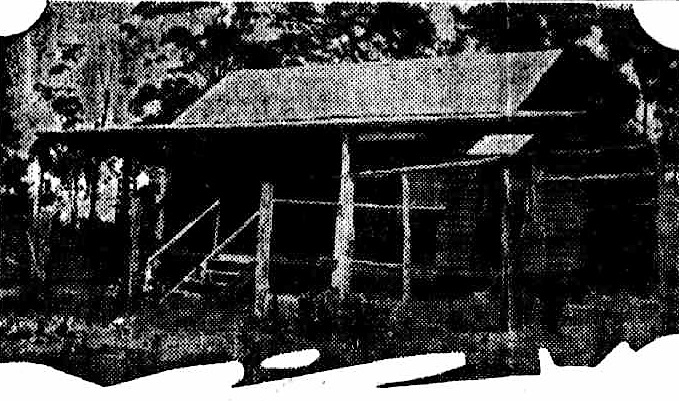
Phillip Jenkins' Cottage in the Narrabeen Bush
IN a weatherboard cottage in the bush at Warriewood, a few miles from Narrabeen, lives a man who, but for an old woman's whim, might today be worth, anything up to a quarter, of a million pounds. He is Phillip Jenkins, sole survivor of a family that settled in the district 100 years ago, and to-wards the end of last century owned, land from Narrabeen to Deewhy
THAT land was transferred to the Salvation Army by Phillip Jenkins' aunt, Miss Elizabeth, and approximately £108,000 has already accrued to the Institution from the sale of a portion of the property. Jenkins fought the Army at law and lost. Now, he receives from the Salvationists an annuity panning out at £2/10/- a week.
.jpg?timestamp=1534833646312)
PHILLIP JENKINS
MIGHT HAVE HAD £250,000, BUT GETS £210- A WEEK (1928, November 3). Smith's Weekly (Sydney, NSW : 1919 - 1950), p. 2. Retrieved from http://nla.gov.au/nla.news-article234382625
Visit: Roads To Pittwater - The Pittwater Road
DEE WHY BEACH MANLY
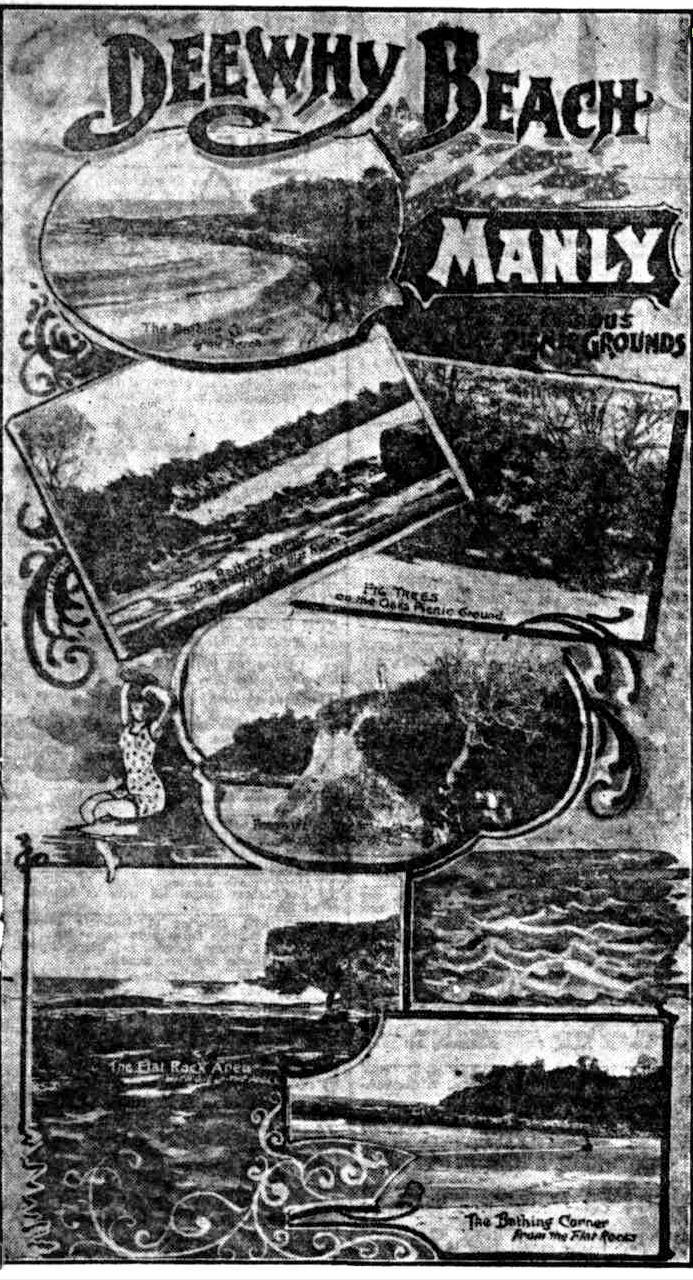
in Sydney's peerless necklace of ocean Jewels Deewhy Beach Is a brilliant gem. It Is one of the most beautiful spots between Manly and Narrabeen — about seven minutes' walk from Pacific Parade, which will shortly be connected by tram to Manly. Dee why Beach has long been' known as one of the choicest picnic resorts around Sydney, but the great .spreading movement which Is now taking place is about to cause this spot to be embraced by the builder, and to become on ideal place of residence for those who either wish to retire In peace to some scene of peace and beauty, or to those who love to spend their week-end where the water is bluest, the sand softest, the surf gentlest, and the air most invigorating.
This resort is now particularly in the public, eye because the famous Oaks Picnic Grounds, which have been known for years as one of Sydney's most attractive pleasure resorts, have been subdivided, and will on Anniversary Day be thrown open to the people for settlement. These grounds are beautifully situated. They are right on the beach front page at Deewhy Head, and command a scene where Nature reposes most gracefully. At the southern end, where the beach touches the estate, there Is fine shelter and a succession of flat rocks, amidst which are many clear crystal pools, admirable for bathing. From southerly busters or westerly gales It Is well protected, and those who make their homes here may enjoy all the pleasures of the sea side without any of its disadvantages.
For the angler this will make an Ideal site for a home, as the schnapper grounds are on the 100ft. reservation outside the eastern boundary, while Long Reef is opposite and Deewhy Lagoon lies at the back of the beach. The 100ft. reservation from the high-tide line enables one to ramble amongst the rocks to view the cliffs 100 to 120 feet high, to study the peculiar pot-holes 10 to 12 foot deep, and to enjoy in the shade the glory of the Pacific. Not only is Deewhy Beach a perfect place for the residence of the city man who, having been confined to his desk all the week, needs a week-end home by the sea, where it Is most restful, but It Is a fine spot for the squatter who would spend his summer at the seaside or the retired man who is seeking health and, peace.
Deewhy Beach Is really not a great distance from the city when one considers that the electric tram, when constructed will be able to land passengers to the Manly boat In fifteen minutes. The whole trip to and from Sydney is therefore well under the hour, but the main point Is that it Is a decidedly refreshing and enjoyable one. To the land speculator the Deewhy Beach Estate offers exceptional Inducements, for, judging by experience in regard to ocean frontages along this coastline, land values are bound to go rapidly ahead. Manly furnishes a striking example of what money can be made by In vestment In this direction. Land sold, only ten years ago from £10 to £15 per foot Is now worth from £30 to £100.. Manly's growing popularity Is bound, when the tram Is extended, to embrace Deewhy Beach, and there is little doubt that values will rise In similar proportion to those at Manly. A great crowd Is expected to attend the sale of the Deewhy Beach Estate on Anniversary Day, and Messrs. Horning and Co. have so provided that the trip may be a picnic as well as a business excursion. DEE WHY BEACH MANLY (1911, January 14). The Sun (Sydney, NSW : 1910 - 1954), p. 4 (FINAL SPORTING). Retrieved from http://nla.gov.au/nla.news-article221565666
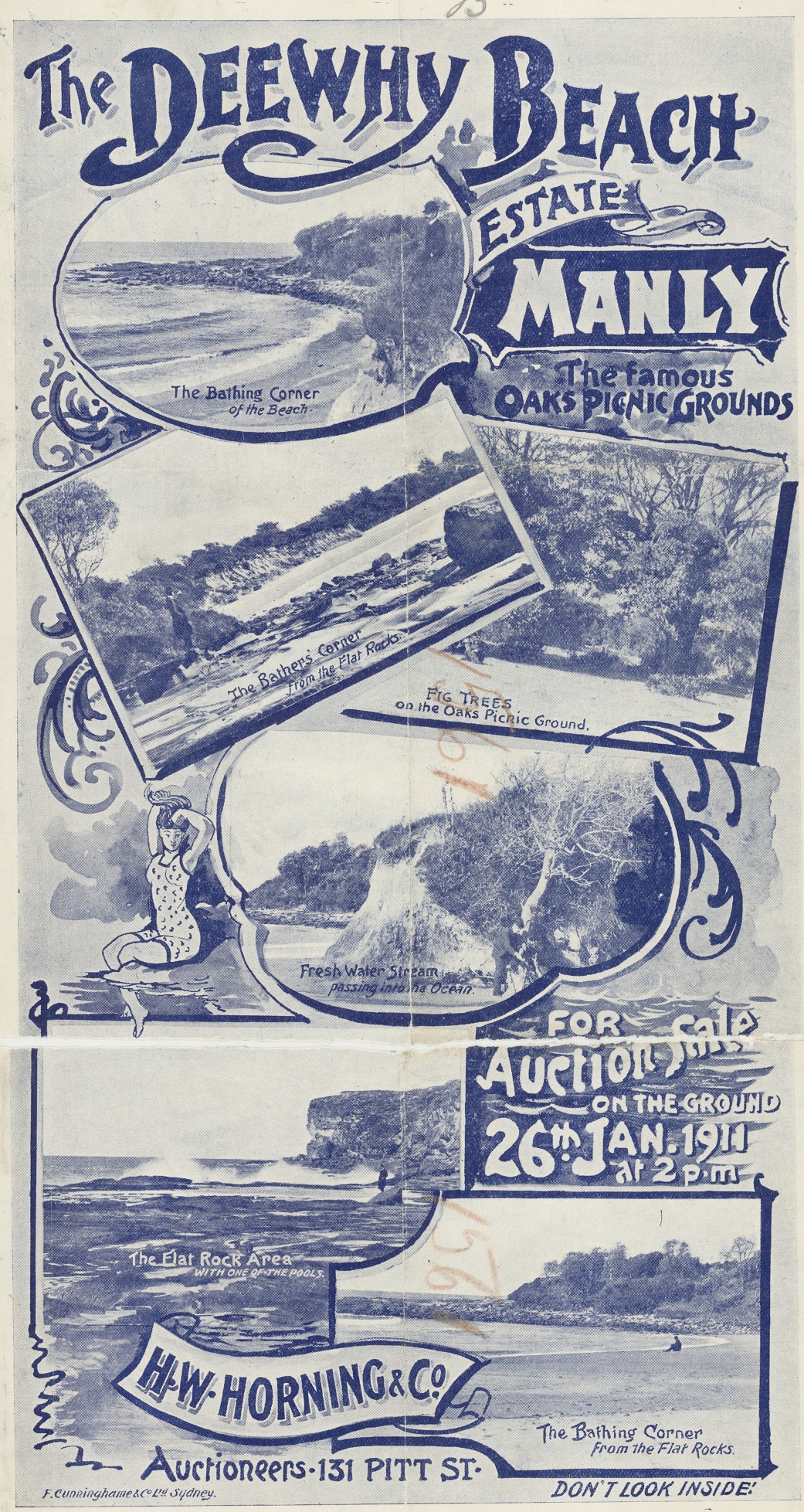
Dee Why Pamphlet 1911, courtesy NSW State Library Dee Why Subdivisions folder
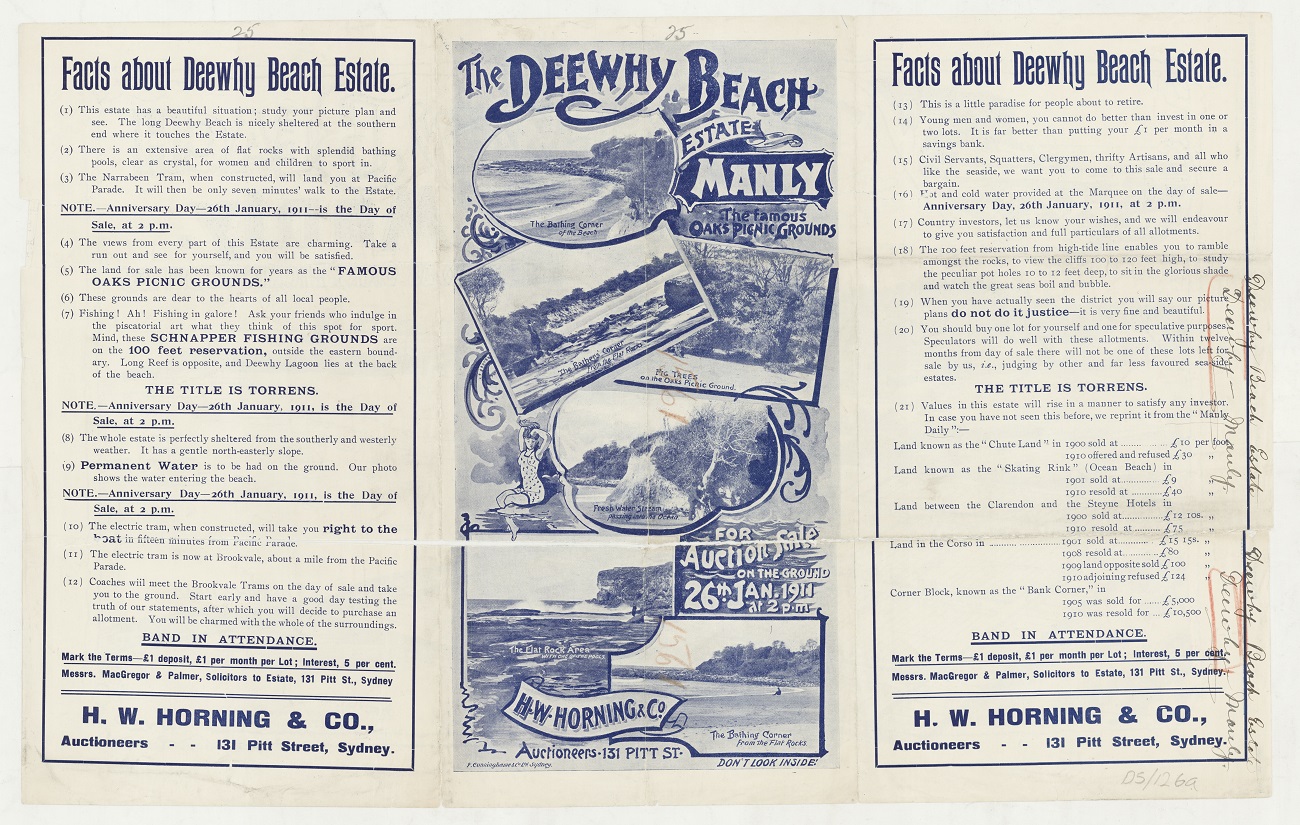
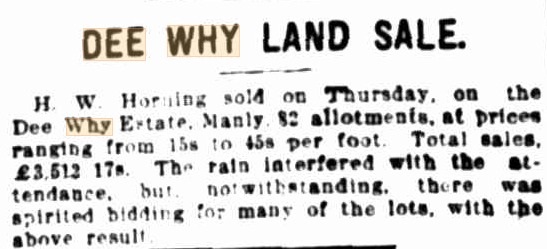
DEE WHY LAND SALE. (1911, January 27). Evening News (Sydney, NSW : 1869 - 1931), p. 5. Retrieved from http://nla.gov.au/nla.news-article113941406
BROOKVALE -NARRABEEN TRAMWAY. FIRST SOD TURNED. MATERIALS TO BE CONVEYED BY TRAM.
The ceremony of turning, the first sod in connection with the three miles extension of the Manly-Brookvale tramway towards Narrabeen was performed yesterday afternoon by the Minister for Works, Mr. Arthur Griffith. After the actual ceremony, at which Master Stuart Griffith assisted, the chairman, Mr. Alexander Ralston, president of the Warringah Shire Council, presented Mr. Griffith with a gold spade suitably inscribed as a memento of the occasion. In supporting this, Dr. Arthur, M.L. A. for the district, referred, to Mr. Griffith's ' brickworks, and said that if he could supply bricks to him at a cheaper rate than private enterprise when he required to build, he would have them, provided they were good. The Narrabeen tramway was badly needed. Mr. Griffith had 'the true interests of this district at heart, and he was sure he would do his best for it. He was hopeful that very shortly the tramway route would be extended as far as Mona Vale and Bayview.
LABOR'S POLICY.
Mr. Griffith, in responding-; said that the general policy of the Labor Government was one of progression, and the extension of some of the schemes of the Wade Government. They had resumed a big area of the foreshores of the harbor, and were about to resume the Salvation Army's property at Long Reef Point. They had also recently resumed an area at Narrabeen for a park site. The construction of the tram extension to Narrabeen would be done as cheaply as possible. The materials would be carried by steamer from Sydney to Manly jetty; taken out of the boat; and placed upon a tram on the wharf. In order that this might be done, he had .arranged with the Port Jackson Ferry Co. to temporary extend ...in the jetty, which would save a great deal of time ... The materials would be run out at half the cost. He hoped that the line would be completed before Christmas so that the public would have the benefit of it during the Summer months. Councillor Quirk proposed the toast of the Federal and State Parliaments, to which Colonel Ryrie, M.H.R,.' Dr. Arthur, Dr.. Naah, Mr.McFarlane, and Mr. Briner, M.L.A'.s responded. Colonel Ryrie mentioned that from 'inside information' it was practically certain that the Mona Vale site for the Naval College had been abandoned, and in that case he would support the Barrenjoey scheme, for he considered Broken Bay and Manly district the back-door to Sydney. BROOKVALE-NARRABEEN TRAMWAY. (1911, July 30).Sunday Times (Sydney, NSW : 1895 - 1930), p. 12. Retrieved from http://nla.gov.au/nla.news-article120689220
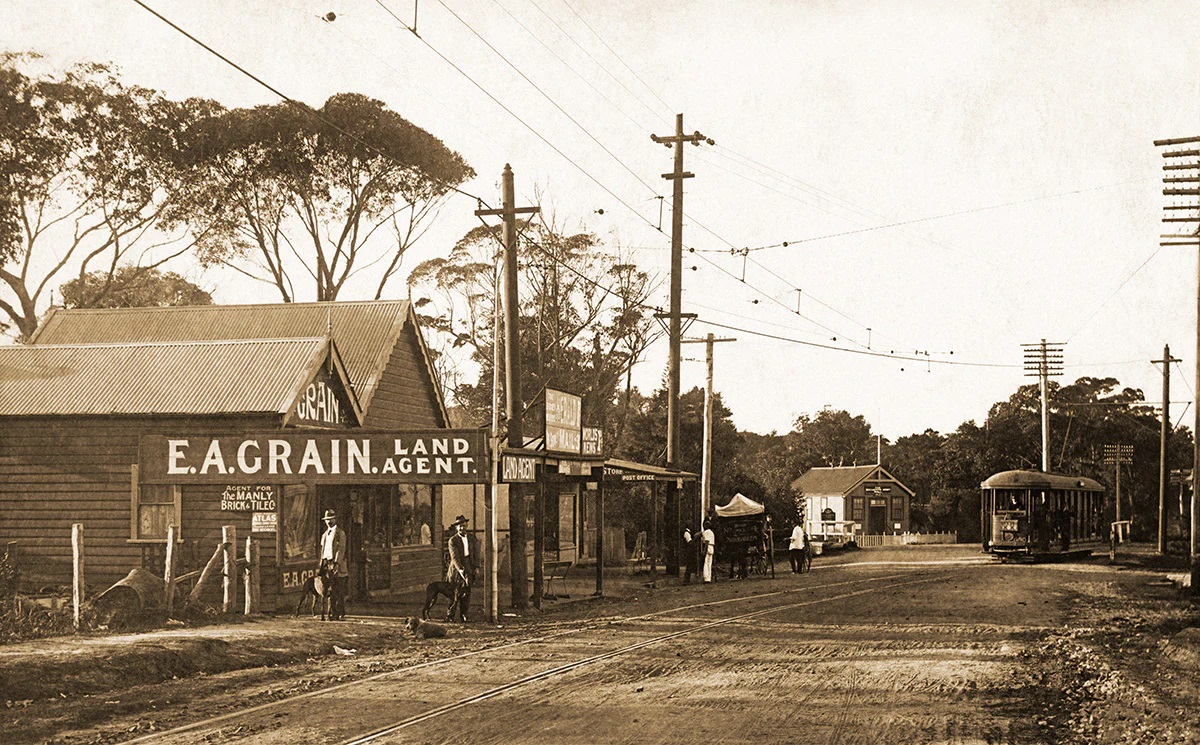
Pittwater road Dee Why, circa 1907-1910
Marriages (per NSW BDM's):
850/1925 TIPPING WILLIAM B MACCONNELL KATHLEEN M REDFERN
22/1912 TIPPING NIGEL PARSONS EMILY SYDNEY
2175/1922 TIPPING WILLIAM G COOK LILY S ST LEONARDS
12760/1923 TIPPING BENJAMIN W HADLEY GRACE V MANLY
16570/1935 TIPPING NEVILLE T BALLARD DOROTHY SYDNEY
5566/1949 TIPPING ANGUS CORNWELL JENKYNS JUNE MOSMAN
Deaths:
TIPPING WILLIAM G15306/1901
TIPPING JEAN G 9422/1924 Parents: BENJAMIN W GRACE V MANLY
TIPPING WILLIAM B20738/1925 Parents: JOHN MARGARET MANLY
TIPPING NIGEL 8536/1951 Parents: WILLIAM MAUDE MANLY
TIPPING.— The Relatives and Friends of KATHLEEN TIPPING, of Dee Why, are requested lo attend the funeral of her late HUSBAND, William B. Tipping, to leave Waugh and C'o.'s Parlors, "The Corso," Manly, by Motor THIS DAY, at 11.20 a.m.. for Manly Cemetery. Family Notices (1925, November 30). The Labor Daily (Sydney, NSW : 1924 - 1938), p. 4. Retrieved from http://nla.gov.au/nla.news-article238121444
Neta, elder daughter of Mr. and Mrs. Nigel Tipping, of Dee Why, to Frederick, youngest son of the late C. Butcher and of Mrs. Butcher, of North Narrabeen. ENGAGEMENTS (1935, October 13). The Sun (Sydney, NSW : 1910 - 1954), p. 40. Retrieved from http://nla.gov.au/nla.news-article231178280
OBITUARY.
Mrs. Fred Butcher
Neta Eileen, wife of Mr Fred Butcher, of Tattersalls Hotel, Dubbo, died on Friday night after a lengthy illness. She was 33 years of age. A daughter, Mary (11), two sons Michael (9) and Peter (7) together with her husband survive. Mrs. Butcher was the daughter of Mr. and. Mrs. Nigel Tipping, of Collaroy and sister of Mr. Michael Tipping, of Dee-Why and Clarice (Mrs. McLaughlin), of Harbord.
The remains were taken to Sydney on Saturday evening, and the funeral left Mary Immaculate Church, Manly, yesterday morning for the Northern Suburbs cemetery where burial was made in the Catholic section at 10 o'clock. A Requiem Mass was celebrated at St. Brigid's, Dubbo, on Saturday morning and also a service at the Manly Church prior to the funeral. W. Larcombe and Son in conjunction with Wood Coffill Ltd., carried out the funeral arrangements. OBITUARY (1948, June 29). The Dubbo Liberal and Macquarie Advocate (NSW : 1894 - 1954), p. 1. Retrieved from http://nla.gov.au/nla.news-article133247794
THE ADULTERATION OF BEER.
(From the Civil Service Gazette.)
The Commissioners of Inland Revenue, in their report just issued, show that the quantity of beer brewed in the United Kingdom during the financial year of 1865 was upwards of 25,000,000 barrels, which is an increase in the last ten years of 41 per cent. The value of such beer, even supposing it to be worth only Is. a gallon, would very nearly be £50,000,000 sterling, and as the same report tells us that beer is now much adulterated, it would be both interesting and important to know the nature and exact amount of the sophistication practised on our national drink before being actually sent into consumption. But as the acquisition of such knowledge is impossible, it may be interesting to review the present methods of adulterations, as far as can be gathered from detections made by those employed to protect the revenue ; and from the ease with which frauds can be committed, and the difficulty of detection, we may safely conclude that much of the beer sold to the public is not genuine. It is a well-known fact that beer is largely adulterated both by brewers and retailers. Of the numerous substances employed to adulterate beer, the following are some of the most common — coriander and carraway seeds, chamomile, quassia, chiretta, wormwood, sweet flag, salt, saltpetre, sulphate of iron, cocculus indicus, and tobacco.
These may be divided into two classes — namely, those which are harmless, and those which cannot be used even in small quantity without injury. The former class includes all except cocculus indicus and tobacco, which belong to the latter class. Since the repeal of the hop duty brewers are allowed to use quassia and bitters of a like nature instead of hops, yet these after all must be designated adulterants, for the public expect that the ale and porter they purchase are brewed wholly from malt and hops, as they are intended for use as beverages and not as medicines. The brewer's province is to brew beer, and not to compound physic, and it would be well for the public if he adhered to his legitimate calling, leaving the study and preparation of medicine to the duly qualified practitioner. Cocculus indicus appears to be an almost essential constituent in the brewing of porter, if the recipes before adverted to are followed.
In numerous instances fragments of this berry have been found among hops which have been used in brewing, and when we consider the probability that only a few ef the revenue officers are acquainted with its appearance, there is reason to believe only a very small per-centage of the adulterations practised are actually discovered. Picrotoxin, the active principle of cocculus indicus, when swallowed does not produce intoxication, but acts as a virulent poison, and a small crystal almost imperceptible to the eye is sufficient to produce a sense of suffocation, and to cause a rush of blood to the head, coldness of the extremities, and other dangerous symptoms. Tobacco is another vegetable poison employed to impart to beer a fictitious appearance of strength by increasing its intoxicating power, and as it is an article of common use there is no difficulty in obtaining any quantity for this highly dangerous and unlawful purpose. The physiological effects on man of the extract of tobacco are so well known that they scarcely need description.
Every smoker can pain'-fully remember the nausea, sickness, and sometimes purging induced by smoking before the system became used to.it. Tobacco extract has a similar effect, only in a greater decree, and if taken in large quantity causes death. Unfortunately for the protection of the public health, neither chemistry nor the microscope ha6 yet afforded much assistance in the detection of the active principle of these pernicious substances when present in beer ; it follows, therefore, that if the adulterating material be not found on the premises of the brewer or retailer, the fraud can be carried on with impunity. In the manufacturing districts, where skilled labour is in demand, and wages are consequently high, the artisans have more money at their dispesal than is required for the common necessaries of life. In these parts of the country drunkenness is very prevalent, and crimes of all sorts are committed, some of them being of such a nature as are almost unknown amongst the rural population. Even when drunkenness has been caused hy wholesome drink, reason for the time is dethroned, and man becomes the slave of brutish passions and propensities : but much more must this be the case ;when the beer has been drugged by cocculus indicus, tobacco, and such like poisonous substances. Several writers have endeavoured to show that crime is in some degree connected with the presence of poisonous weeds in the barley crops, and that as the season is prolific in producing these weeds, se does crime increase. There may be a small amount of probability in the suggestion, but as the best crops only of barley are used to make malt, and the mechanical appliances used by the farmer for separating foreign seeds are well-nigh perfect, it is unlikely that the beer brewed from such malt should contain more than a trace of poisonous matter. If the exact amount of hurtful adulteration practised on beer could be known, it is likely a strong connection between it and crime could be traced. We hope that at no distant day the Legislature will consider it part of their duty to cause all diligence to be employed in protecting the public against the frauds so commonly practised on our national beverage. THE ADULTERATION OF BEER. (1867, May 25). Sydney Mail (NSW : 1860 - 1871), p. 7. Retrieved from http://nla.gov.au/nla.news-article166803446
the extension estate, dee why, 1920
courtesy State Library of NSW: from Dee Why Subdivisions maps folder

.jpg?timestamp=1696883893646)


.jpg?timestamp=1696883992002)
.jpg?timestamp=1696884049440)
.jpg?timestamp=1696884086939)